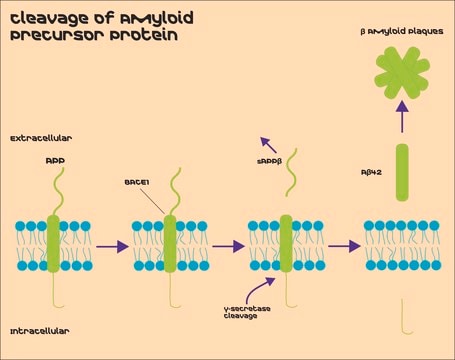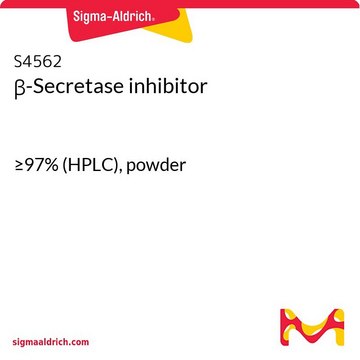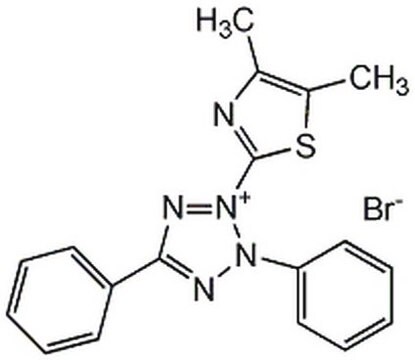추천 제품
사용
sufficient for 100 tests
Quality Level
제조업체/상표
Calbiochem®
저장 조건
OK to freeze
avoid repeated freeze/thaw cycles
protect from light
입력
sample type tissue extract(s)
sample type purified enzyme(s) (BACE)
sample type cell lysate
검출 방법
fluorometric
저장 온도
−20°C
일반 설명
A sensitive fluorogenic assay kit for the determination of β-secretase (BACE) activity (Excitation max: 335-355 nm; Emission max: 495-501 nm). β-Secretase is a transmembrane aspartyl protease that cleaves membrane-bound amyloid precursor protein.
성분
Extraction Buffer, Reaction Buffer, β-Secretase Substrate, β-Secretase Protein (Positive Control), β-Secretase Inhibitor, and a user protocol.
경고
Toxicity: Multiple Toxicity Values, refer to MSDS (O)
원리
The Calbiochem β-Secretase Activity Assay Kit, Fluorogenic, is intended for measuring the β-secretase (BACE) activity in cell lysates, tissue extracts, or purified enzyme preparations.
제조 메모
• Active β-Secretase: Reconstitute the lyophilized Active β-Secretase with 10 µl ddH2O. Following reconstitution, aliquot and freeze (-70°C) to avoid loss of activity.
저장 및 안정성
Upon arrival store the entire contents of the kit at -20°C. Following reconstitution of the Active β-Secretase, aliquot and freeze (-70°C) to avoid loss of activity. Following initial thaw of the kit contents, store the Extraction Buffer and 2X Reaction Buffer at 4°C.
기타 정보
Due to the nature of the Hazardous Materials in this shipment, additional shipping charges may be applied to your order. Certain sizes may be exempt from the additional hazardous materials shipping charges. Please contact your local sales office for more information regarding these charges.
법적 정보
CALBIOCHEM is a registered trademark of Merck KGaA, Darmstadt, Germany
신호어
Danger
유해 및 위험 성명서
Hazard Classifications
Eye Dam. 1 - Muta. 2 - Skin Irrit. 2
Storage Class Code
10 - Combustible liquids
시험 성적서(COA)
제품의 로트/배치 번호를 입력하여 시험 성적서(COA)을 검색하십시오. 로트 및 배치 번호는 제품 라벨에 있는 ‘로트’ 또는 ‘배치’라는 용어 뒤에서 찾을 수 있습니다.
3K3A-activated protein C blocks amyloidogenic BACE1 pathway and improves functional outcome in mice.
Divna Lazic et al.
The Journal of experimental medicine, 216(2), 279-293 (2019-01-17)
3K3A-activated protein C (APC), a cell-signaling analogue of endogenous blood serine protease APC, exerts vasculoprotective, neuroprotective, and anti-inflammatory activities in rodent models of stroke, brain injury, and neurodegenerative disorders. 3K3A-APC is currently in development as a neuroprotectant in patients with
Lei Liu et al.
The Journal of cell biology, 218(2), 644-663 (2019-01-11)
Intramembrane proteolysis of transmembrane substrates by the presenilin-γ-secretase complex is preceded and regulated by shedding of the substrate's ectodomain by α- or β-secretase. We asked whether β- and γ-secretases interact to mediate efficient sequential processing of APP, generating the amyloid
Crystal D Hayes et al.
BMC medicine, 11, 81-81 (2013-03-28)
Currently available therapies for Alzheimer's disease (AD) do not treat the underlying cause of AD. Anecdotal observations in nursing homes from multiple studies strongly suggest an inverse relationship between cancer and AD. Therefore, we reasoned that oncology drugs may be
Yan Cai et al.
Neurotoxicity research, 21(2), 160-174 (2011-07-05)
β-amyloid precursor protein (APP) and presenilins mutations cause early-onset familial Alzheimer's disease (FAD). Some FAD-based mouse models produce amyloid plaques, others do not. β-Amyloid (Aβ) deposition can manifest as compact and diffuse plaques; it is unclear why the same Aβ
Xue-Mei Zhang et al.
The European journal of neuroscience, 31(4), 710-721 (2010-04-14)
Cerebral hypometabolism and amyloid accumulation are principal neuropathological manifestations of Alzheimer's disease (AD). Whether and how brain/neuronal activity might modulate certain pathological processes of AD are interesting topics of recent clinical and basic research in the field, and may be
자사의 과학자팀은 생명 과학, 재료 과학, 화학 합성, 크로마토그래피, 분석 및 기타 많은 영역을 포함한 모든 과학 분야에 경험이 있습니다..
고객지원팀으로 연락바랍니다.


![MCA-[Asn670, Leu671]-Amyloid β/A4 Precursor Protein 770 Fragment 667-676-DNP-Lys-Arg-Arg-NH2 ≥90% (HPLC)](/deepweb/assets/sigmaaldrich/product/images/375/511/f63f11a7-86de-45c4-95a0-7afa616bb265/640/f63f11a7-86de-45c4-95a0-7afa616bb265.jpg)






